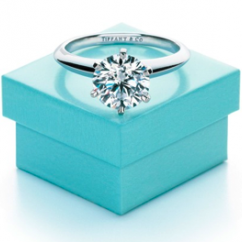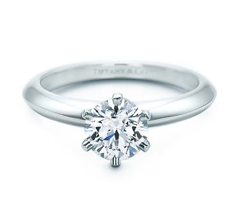Articles and News
WILL IT STILL BE OKAY TO SAY ‘TIFFANY SETTING’ AT THE COUNTER? | March 20, 2013 (0 comments)

New York, NY—The ongoing brawl between Costco and Tiffany may have far-reaching implications for the entire jewelry industry.
Luxury jeweler Tiffany & Co. last month sued Seattle, WA—based Costco for improper use of its name to describe some of the warehouse club’s engagement ring merchandise. But instead of meekly agreeing to cease and desist, Costco threw a punch of its own, saying the term “Tiffany setting” has become generic to describe a simple six-prong setting for a diamond solitaire ring, and that it was not representing the rings in its cases as Tiffany-manufactured product.
Does Tiffany—the inventor of the setting in 1886—have the right to prevent anyone else from using a term that’s been widely used for decades in all sectors of the jewelry industry, as well as by consumers?
Last week the retailer in a court filing said “yes,” and if it wins this latest battle, jewelers everywhere—including luxury independents—will have to find another way to describe a simple solitaire, biting their tongues until they get out of the habit of calling it a Tiffany setting.
But that’s where things may get interesting, says Peter Berger, an intellectual-property attorney with New York-based Levisohn Berger LLP. While initially it appeared that Tiffany was going to go to the mat to defend any use of its name, Berger believes the luxury retailer now may back off that stance and focus on defending only the actual registered trademark (“Tiffany®”) to prevent the sale of counterfeit merchandise, not the generic use of the term “Tiffany setting.”
In other words, fight a battle you can win, not a war you may lose, says Berger. Tiffany will—and should—successfully prevent other sellers from misrepresenting product as Tiffany-made. But the retailer hasn’t stopped other manufacturers from making a simple four- or six-prong solitaire setting without a Tiffany mark on it. And stopping the industry from using what has become a common descriptor may be harder than stopping the proverbial speeding train.


The ring on the left bears the Tiffany & Co. trademark inside, indicating it was made by Tiffany. But the company hasn't prevented other manufacturers (right) from making a simple six-prong setting for a diamond solitaire without a Tiffany trademark.
How could Tiffany potentially lose what seems like an obvious slam-dunk?
Because of history, says Berger. Tiffany today is known to aggressively defend its name and trademarked designs, but decades ago it was more lenient, and in one case Berger defended, even allowed his client to use the name coupled with another name, in certain wording.
If a company isn’t firm about the use of its name early, it’s hard to backpedal later, Berger explained. As a result, Costco may have the better side of the argument in claiming that the term “Tiffany setting” has become generic, he told The Centurion.
For example, escalator, margarine, and cellophane were originally trademarks for specific products. But the manufacturers of those products didn’t defend them, and they fell into generic use. On the other hand, Xerox, Kimberly Clark (Kleenex), and Frigidaire did defend their brands and kept the right to prevent others from using it. Eventually, even noncommercial references fall into line.
“When I was a child, everyone called a refrigerator a ‘Frigidaire,’ regardless of who made it. But Frigidaire fought and now everybody calls it a refrigerator,” said Berger.
In the office, we now routinely “copy” a document, not “Xerox it,” as was common parlance when photocopiers were first developed and Xerox, the inventor, was the market leader. And today’s consumers now hunt for a tissue, not a Kleenex, when they sneeze.
“When something describes a product, it’s not a trademark,” says Berger. “Chrysler almost lost [the rights to trademark] Jeep. After World War II, any vehicle like that was called a Jeep. They weren’t ‘SUV’s.’ Chrysler fought very hard to reclaim Jeep as a trademark—and came very close to losing—but now everybody calls that kind of vehicle an SUV unless it really is a Jeep.” (Editor’s note: Chrysler didn’t acquire Jeep until 1987—more than four decades after the war—so the term was in common usage by then. But as a new owner of the brand, Chrysler did not have a past history of not defending the name.)
While attorneys for Tiffany cited Costco’s use of “unreliable sources” as its evidence for generic use of the term, those sources aren’t exactly obscure. They include, among others, Wikipedia and a tome on wedding planning that is part of the hugely popular “For Dummies” series of how-to books. With more than 250 million volumes covering topics as broad-based as raising a golden retriever to understanding economics, the Dummies books are hardly “unreliable.”

The For Dummies series has more than 1,800 titles and 250 million volumes in print, translated into more than 30 languages. According to the publisher's website,10 For Dummies books are sold every minute in the United States, and at least one every 10 minutes in other English-speaking countries.
“The way I read Tiffany’s reply to Costco’s counter-complaint, I think they will step back on the generic usage of “Tiffany setting” and focus on making sure nobody is selling counterfeit Tiffany product,” said Berger. “You can’t be sure, but I’m trying to imagine what’s in their minds,” he acknowledges. The fifth paragraph in the reply actually kind of supports the idea of “Tiffany setting” in generic usage, he explained.
In the meantime, he says, luxury jewelers can still comfortably say “Tiffany setting,” as long as they’re not in any way representing their product as “Tiffany®,” meaning that it is, in fact, made by Tiffany.
That ring still can only come in the famous little blue box.







